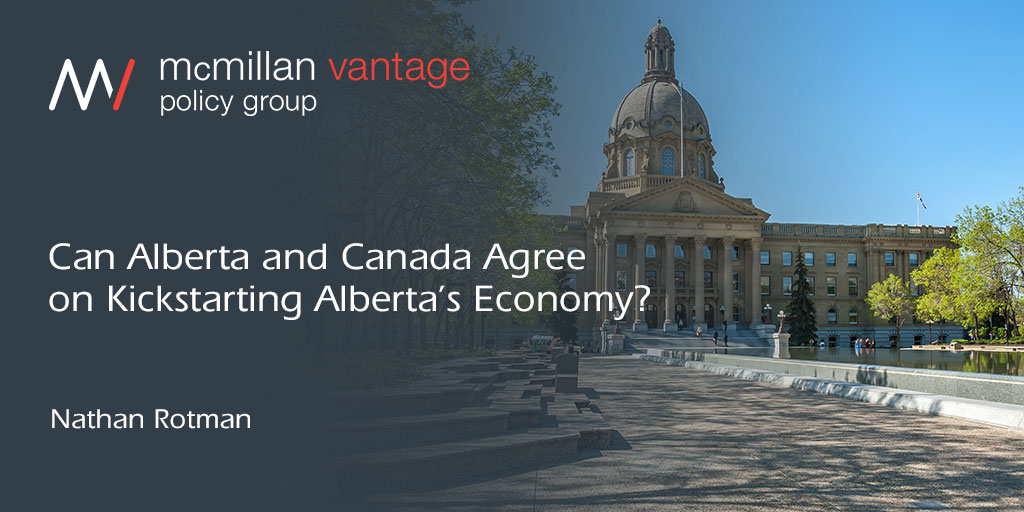There’s a time-tested bumper sticker in Alberta that reads, “please God, give me one more oil boom. I promise not to piss it all away next time.” Booms and busts are no strangers to Alberta, but this time the bust has lasted longer and there’s no signs of a boom in sight. Blame OPEC, the pandemic, or ongoing drama of failing to get product to more markets, Alberta is in rough shape. It’s time to focus quickly on diversifying its energy industry—with the support of every Canadian and our federal government.
This is not news to most Albertans. In 1972, less than ten years after operations in the first commercial oil sands project began, Premier Peter Lougheed argued the province couldn’t live off the riches of exporting raw resources forever and that diversification was essential. This does not mean abandoning the oil and gas sector, but it does mean investing in it in a way that adds value to Alberta’s vast resources. And it can only happen if Ottawa recognizes the role the sector can play in acting on climate change.
Alberta governments pushing for a more diversified economy is nothing new, but the current and compounding crises make the case to act now.
First, the industry is already challenged to raise capital. Whether it’s a new found reluctance by international investors like HSBC or Blackrock to invest in the oilsands or regulatory uncertainty scaring away investors as we saw in Kinder Morgan’s abandonment of the Trans Mountain pipeline expansion, the hurdles are high. As the economy reboots after COVID-19, global pressure to use environmentally positive stimulus will only increase. Alberta is well- placed to attract that private investment.
Second, there is no increase in oil prices on the horizon. Even with this weekend’s OPEC truce, Alberta has only one customer and limited market access, even to America. True, the Trans Mountain pipeline expansion is underway, but it is not set to begin shipments until the end of 2022. Even then, higher prices will depend upon a global demand profile for oil that is uncertain.
The horrible truth is that the coronavirus pandemic has already led to economic disruption of unprecedented proportions. Every Canadian feels it, but nowhere more than in Alberta. This is not a bust like the others and so the recovery cannot be like those that came before. The federal and Alberta governments can’t follow the well-worn wagon tracks of a boom/bust economy.
Petrochemical upgrading
While more pipeline capacity will help the province’s books, it won’t be felt by ordinary Albertans who need immediate action to supercharge a long-term economic recovery. Nowhere is Canada’s place as hewers of wood and drawers of water more evident than in Alberta, which ships raw product to the United States where value is added through upgrading. While investing in gasoline refineries may not feasible in Alberta, the province can nonetheless seize significant opportunities if Ottawa is willing to help by incentivizing new streams of manufacturing.
It could, for example, take advantage of record-low natural gas prices by taking low value natural gas molecules and moving them up the value chain to create more valuable chemical or consumer products—tires, diapers, and even the much-coveted N-95 masks which require polypropylene fibre. This is no secret and there is significant industry interest in making these kinds of products. Premiers Jim Prentice Rachel Notley, and Jason Kenney have all recognized this opportunity. Adding to existing provincial incentives could help spur a lucrative processing and manufacturing sector that would employ thousands of Albertans without the same transportation constraints and drama that exporting raw product causes.
Energy Transition
Alberta remains Canada’s largest user of coal-powered electricity. A number of forward-thinking electricity producers have been planning the transition away from this climate-changing form of generation by investing in natural gas generation and innovative hydro projects. For example, a 2017 auction for renewable electricity secured more than $1 billion in private investment for wind power for half the price Ontario paid only one year earlier. The federal government has a significant role it could play in clean electricity generation, which would help Alberta a great deal. In fact, former Natural Resources Minister Jim Carr was optimistic about more national cooperation on this front.
Innovation
Alberta industry and academia came together in impressive ways to bid on federal financing for a clean energy supercluster prior to the last election. The project would have built on Alberta’s longstanding history of innovation and focused on conducting research into low-emission end uses for hydrocarbons for instance. Unfortunately, the Clean Resources Innovation Network (CRIN) didn’t get the funding it wanted at the time, but the project lived on thanks to industry support, two impressive research universities and later government engagement. Additionally, the federal government need look no further than the exciting work happening in artificial intelligence at the University of Alberta’s AMii, health, agriculture and energy research at Alberta Innovates, a provincial crown corporation, or the impressive CRIN network to find excellent partners with big ideas in need of capital, research and commercialization support.
Unlike our neighbours to the south, the pandemic crisis has already seen a surprising easing of tensions between the various political forces in the country. While there is no doubt this won’t last, the federal government can and should provide a thoughtful response to a uniquely Albertan challenge that has created uniquely Western frustrations with the federation. When SARS ravaged Toronto’s tourism industry, the federal government crafted a unique response. As this pandemic compounds Alberta’s pre-existing conditions, a tailor-made response is also required—to put Albertans back to work and help us all meet Canada’s climate goals.
